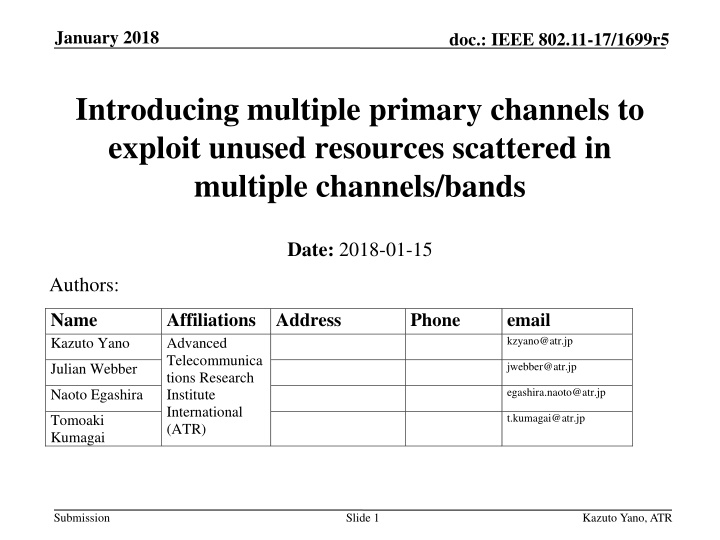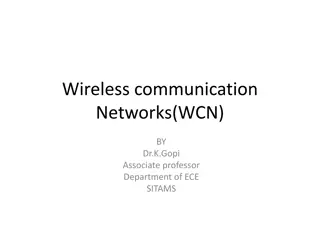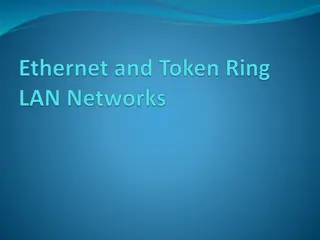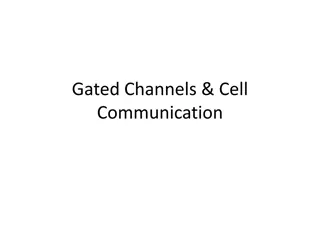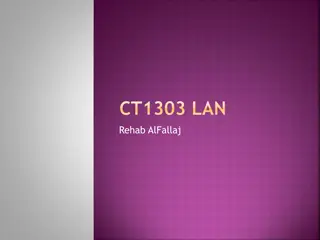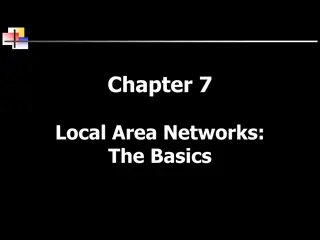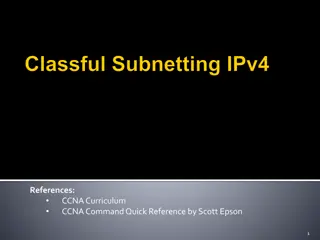Enhancing Wireless LAN Throughput with Multiple Primary Channels
This document discusses the need for increasing system throughput in wireless LAN networks due to the growing demand for WLAN traffic. By introducing multiple primary channels, unused resources scattered across various channels can be exploited to improve quality of service and enhance transmission opportunities for stations. The proposal involves employing multiple primary channels in different frequency bands, allowing stations to independently access these channels and potentially double achievable throughput in certain scenarios.
Download Presentation

Please find below an Image/Link to download the presentation.
The content on the website is provided AS IS for your information and personal use only. It may not be sold, licensed, or shared on other websites without obtaining consent from the author.If you encounter any issues during the download, it is possible that the publisher has removed the file from their server.
You are allowed to download the files provided on this website for personal or commercial use, subject to the condition that they are used lawfully. All files are the property of their respective owners.
The content on the website is provided AS IS for your information and personal use only. It may not be sold, licensed, or shared on other websites without obtaining consent from the author.
E N D
Presentation Transcript
January 2018 doc.: IEEE 802.11-17/1699r5 Introducing multiple primary channels to exploit unused resources scattered in multiple channels/bands Date: 2018-01-15 Authors: Name Kazuto Yano Affiliations Address Advanced Telecommunica tions Research Institute International (ATR) Phone email kzyano@atr.jp jwebber@atr.jp Julian Webber egashira.naoto@atr.jp Naoto Egashira t.kumagai@atr.jp Tomoaki Kumagai Submission Slide 1 Kazuto Yano, ATR
January 2018 doc.: IEEE 802.11-17/1699r5 Background (1) The amount of wireless LAN traffic is still increasing due to expansion of applications and off-loading of cellular traffic. To meet the increasing demand, enhancement of system throughput of the wireless LAN is still necessary. WLAN traffic becomes 4 times in 5 years. Growth of IP traffic forecasted by Cisco [1]. Submission Slide 2 Kazuto Yano, ATR
January 2018 doc.: IEEE 802.11-17/1699r5 Background (2) 500 We conducted measurements of channel usage at a main-line railway station in Japan [2,3]. Measured spectrogram shows that even though some channels are crowded, there are many short unused resources with durations of typically 10-70 ms. If we can utilize these scattered unused resources at a STA, we can obtain more transmission chances and can improve QoS. 400 300 200 100 0 Ch. 1 (Left) 2.4 and (Right) 5 GHz Spectrogram 6 108 112 116 Submission Slide 3 Kazuto Yano, ATR
January 2018 doc.: IEEE 802.11-17/1699r5 Background (3) In current IEEE 802.11 wireless LAN, a BSS sets one primary channel (PCH) on which each STA invokes the back-off procedure to obtain a transmission opportunity (TXOP) [4]. However, if channel load of the PCH is relatively high, some STAs would hardly obtain enough TXOPs to achieve required QoS even though unused resources exist on other channels. Frame from other STA Frequency My transmitted frame PCH Secondary channel Time These unused resources are not available. Submission Slide 4 Kazuto Yano, ATR
January 2018 doc.: IEEE 802.11-17/1699r5 Contents of this presentation We have presented some basic ideas to exploit such scattered unused resources to obtain more transmission chances [2,3,5]. This presentation proposes to employ multiple PCHs to exploit such unused resources. This presentation also introduces several ways of channel access to utilize multiple PCHs. Simulation results show that achievable throughput becomes more than double by employing two PCHs in some cases. Submission Slide 5 Kazuto Yano, ATR
January 2018 doc.: IEEE 802.11-17/1699r5 Multiple PCHs on multiple channels/bands To obtain a transmission chance even when the primary channel is busy, we propose to set multiple PCHs. These PCHs can be set in different frequency bands. A STA independently invokes the back-off process using EDCAF (or DCF) on each PCH. Frequency My transmitted frame Waiting on back-off Frame from other STA Band A PCH 1 Secondary channel for PCH 1 PCH 2 Secondary channel for PCH 2 Band B PCH 3 Secondary channel for PCH 3 Time Submission Slide 6 Kazuto Yano, ATR
January 2018 doc.: IEEE 802.11-17/1699r5 How to access multiple PCHs There are three ways to transmit a frame on PCHs. a. Simultaneous transmission on multiple PCHs : Transmit a channel- bonded frame across multiple PCHs on which transmission chances are obtained (similar to 80+80 MHz non-contiguous transmission in 802.11ac). b. Concurrent (asynchronous) transmission on multiple PCHs : Transmit a frame immediately on a PCH if a transmission chance is obtained on the PCH. If inter-channel interference is negligible (frequency separation between PCHs is large), multiple frames can be concurrently transmitted on different PCHs. c. Non-concurrent transmission : Transmit a frame immediately on a PCH if a transmission chance is obtained on the PCH. If inter- channel interference is not negligible (frequency separation between PCHs is small), only one frame can be transmitted at a time. Submission Slide 7 Kazuto Yano, ATR
January 2018 Simultaneous transmission on multiple PCHs doc.: IEEE 802.11-17/1699r5 If transmission chances are obtained on multiple PCHs, a channel-bonded frame is transmitted on the PCHs. If OFDM(A) is used, this method is available even when PCH separation is small due to synchronous transmission. If the PCHs used for simultaneous transmission are far apart in the frequency domain, high frequency-diversity gain is expected. Frequency Back-off slot Waiting to finish back- off on other PCH Back-off finish Band A PCH 1 Secondary channel for PCH 1 PCH 2 Secondary channel for PCH 2 Band B PCH 3 Secondary channel for PCH 3 Time Submission Slide 8 Kazuto Yano, ATR
January 2018 Concurrent transmission on multiple PCHs doc.: IEEE 802.11-17/1699r5 If a transmission chance is obtained on one of the multiple PCHs, a frame is immediately transmitted on that PCH. Concurrent transmission is available only when PCH separation is large so that inter-channel interference is negligible. A STA may delay frame transmission until another PCH finishes back-off to perform simultaneous transmission. Frequency Band A PCH 1 Secondary channel for PCH 1 ~~ PCH 2 Secondary channel for PCH 2 Band B PCH 3 Secondary channel for PCH 3 Time Submission Slide 9 Kazuto Yano, ATR
January 2018 doc.: IEEE 802.11-17/1699r5 Non-concurrent transmission If inter-channel interference is not negligible, a STA can transmit a frame only on one PCH at a time even when transmission chances are obtained on multiple PCHs. However, transmission chances will be increased by setting multiple PCHs if unused resources are scattered. Frequency Busy due to inter-channel interference Band A PCH 1 Secondary channel for PCH 1 PCH 2 Secondary channel for PCH 2 Time Submission Slide 10 Kazuto Yano, ATR
January 2018 doc.: IEEE 802.11-17/1699r5 Queue sharing among PCHs To effectively exploit unused resources scattered in the time and frequency domains, EDCA queue is shared by multiple PCHs. MSDU is de-queued to the PCH on which a transmission chance is obtained. Submission Slide 11 Kazuto Yano, ATR
January 2018 doc.: IEEE 802.11-17/1699r5 Loading simulation (1/3) We assume one target BSS and 8 legacy OBSSs. Each BSS has 2 non-AP STAs. 2 PCHs (ch 36 and ch 100) are set in 5 GHz band. The target BSS can use both PCHs. Each OBSS can use either of PCHs. Both ch 36 and ch 100 are used by 4 OBSSs. Each STA has downlink traffic with 96000-byte payload. The target BSS has full-buffer traffic to evaluate achievable throughout. Each OBSS has traffic with exponentially-distributed packet arrival interval. (Average packet arrival interval : 100 ms) The multi-PCH performance is compared with single-PCH. One RF chain is employed for each PCH. Submission Slide 12 Kazuto Yano, ATR
January 2018 doc.: IEEE 802.11-17/1699r5 Loading simulation (2/3) For simplicity, we conduct simulations based on 802.11ac with maximum transmission bandwidth of 80 MHz. Following cases are compared: The target BSS uses only one PCH on ch 36. The target BSS performs concurrent transmission (CT). The target BSS performs simultaneous transmission (ST). It waits up to 120 s to obtain TXOP on both PCHs. If a STA judges that it cannot obtain TXOP on another PCH, it immediately transmits a frame on one PCH with non- concurrent transmission (non-CT). Submission Slide 13 Kazuto Yano, ATR
January 2018 doc.: IEEE 802.11-17/1699r5 Loading simulation (3/3) Area size : 60 m x 60 m (20 m x 20 m segment, 3 x 3 segments) Position of AP/STA : uniformly random in a segment Propagation model : based on the residential scenario (SS1) in the IEEE 802.11 TGax simulation scenarios [6]. Tx power : 20 dBm per PCH (AP), 15 dBm per PCH (STA) Submission Slide 14 Kazuto Yano, ATR
January 2018 doc.: IEEE 802.11-17/1699r5 Simulation results (1/3) Used MCS Index : 2 Average offered traffic load of OBSSs : 70 % (in PHY layer) CT improves 10%, 50%, 90% throughput by 125%, 109%, 90% without degrading OBSS s performance. ST improves 10%, 50%, 90% throughput by 86%, 75%, 62%. Target BSS OBSSs (8 BSSs) Submission Slide 15 Kazuto Yano, ATR
January 2018 doc.: IEEE 802.11-17/1699r5 Simulation results (2/3) Used MCS Index : 3 Average offered traffic load of OBSSs : 53 % (in PHY layer) CT improves 10%, 50%, 90% throughput by 120%, 105%, 88% without degrading OBSS s performance. ST improves 10%, 50%, 90% throughput by 79%, 73%, 65%. Target BSS OBSSs (8 BSSs) Submission Slide 16 Kazuto Yano, ATR
January 2018 doc.: IEEE 802.11-17/1699r5 Simulation results (3/3) Used MCS Index : 4 Average offered traffic load of OBSSs : 35 % (in PHY layer) CT improves 10%, 50%, 90% throughput by 109%, 103%, 93% without degrading OBSS s performance. ST improves 10%, 50%, 90% throughput by 66%, 70%, 69%. Target BSS OBSSs (8 BSSs) Submission Slide 17 Kazuto Yano, ATR
November 2017 doc.: IEEE 802.11-17/1699r5 Summary To exploit unused resources scattered in time and frequency domains and obtain transmission chances on such resources, we have proposed to set multiple PCHs and three ways to use obtained transmission chances. Simultaneous (channel-bonded) transmission on multiple PCHs Concurrent (asynchronous) transmission on multiple PCHs Non-concurrent transmission We have confirmed through computer simulation that the proposed methods can achieve higher throughput than current single-PCH transmission without degrading the performance of legacy WLANs. Submission Slide 18 Kazuto Yano, ATR
November 2017 doc.: IEEE 802.11-17/1699r5 Straw Poll Do you think that introducing multiple primary channels is an effective way to enhance achievable QoS? Yes: No: Need more information: Abstain: Submission Slide 19 Kazuto Yano, ATR
November 2017 doc.: IEEE 802.11-17/1699r5 References [1] Cisco, Cisco Visual Networking Index: Global Mobile Data Traffic Forecast Update, 2016 2021, Cisco White Paper C11-738429-00, February 2017. [2] doc. IEEE 802.11-17/0410r0. [3] doc. IEEE 802.11-17/0767r0. [4] IEEE 802.11-2016. [5] doc. IEEE 802.11-17/0129r3. [6] doc. IEEE 802.11-14/0980r16. Submission Slide 20 Kazuto Yano, ATR
